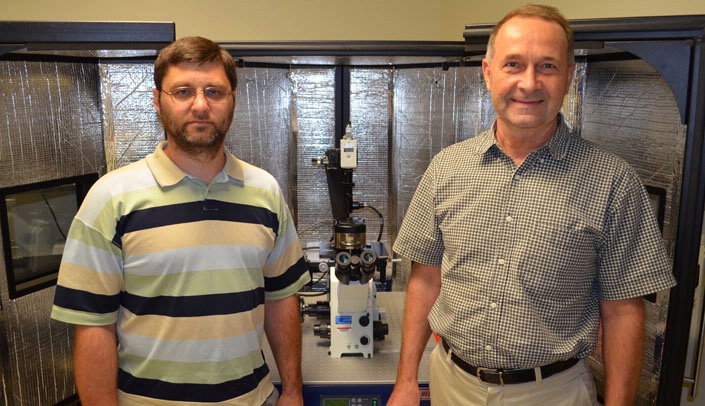UNMC's nanoimaging core facility has reopened, complete with a set of four instruments that make it among the most versatile facilities of its kind in the country.
For more information
For more information, or to request usage of the nanoimaging core, please contact Dr. Krasnoslobodtsev or Dr. Lushnikov at 402-559-2597 or 402-559-2596.
Facility director Alexey Krasnoslobodtsev, Ph.D., a professor of physics who is leading the biomedical physics program at the University of Nebraska at Omaha, said interest among researchers has been high in the reopened facility, and not only at UNMC. Since reopening July 1, the facility — based at UNMC — has served researchers from Creighton University, the University of Cincinnati and Ball State University in Indiana. Part of the facility's draw is its array of technology — four instruments that are capable of a wide variety of nanoimaging. "The nanoimaging core facility is primarily based on atomic force microscopy," Dr. Krasnoslobodtsev said. "The resolution of AFM is about 1,000 times better than optical microscopy. So essentially, everybody who's working with nano-sized objects can use AFM." The four instruments in the facility are "built around atomic force microscopy, but they serve different functions," he said. The instruments include:
- Bruker MultiMode, which can image in liquid as well as air;
- Asylum Research AFM, designed to primarily image objects in liquid, and one of the first instruments that has been designed to do force spectroscopy — measuring tiny forces between objects;
- JPK Germany's ForceRobot 300, designed for force spectroscopy;
- An instrument from NT-MDT that has about 20 different AFM modes and also can measure magnetic and conductive properties of materials. The instrument itself is a combination of AFM and Raman spectroscopy capable of simultaneous AFM and spectroscopic measurements.
Dr. Krasnoslobodtsev and Alexander Lushnikov, Ph.D., the facility's imaging specialist, are excited by the possibilities of the reopened facility. "It is a unique setup," Dr. Krasnoslobodtsev said. "This month we've been really busy, just one project after another . . . Some customers have had publications waiting since last December, because they wanted to have AFM images included in their publication. "It's been a good experience, because we don't just do one type of project. Everyone's coming with their projects, and I'm always excited about learning something knew. And some of the projects, I knew theoretically that our instruments can do them, but we've never done them before. It's very interesting — new things are always hard, especially with the high tech. But I'm excited that we are getting a variety of projects we can work on."
